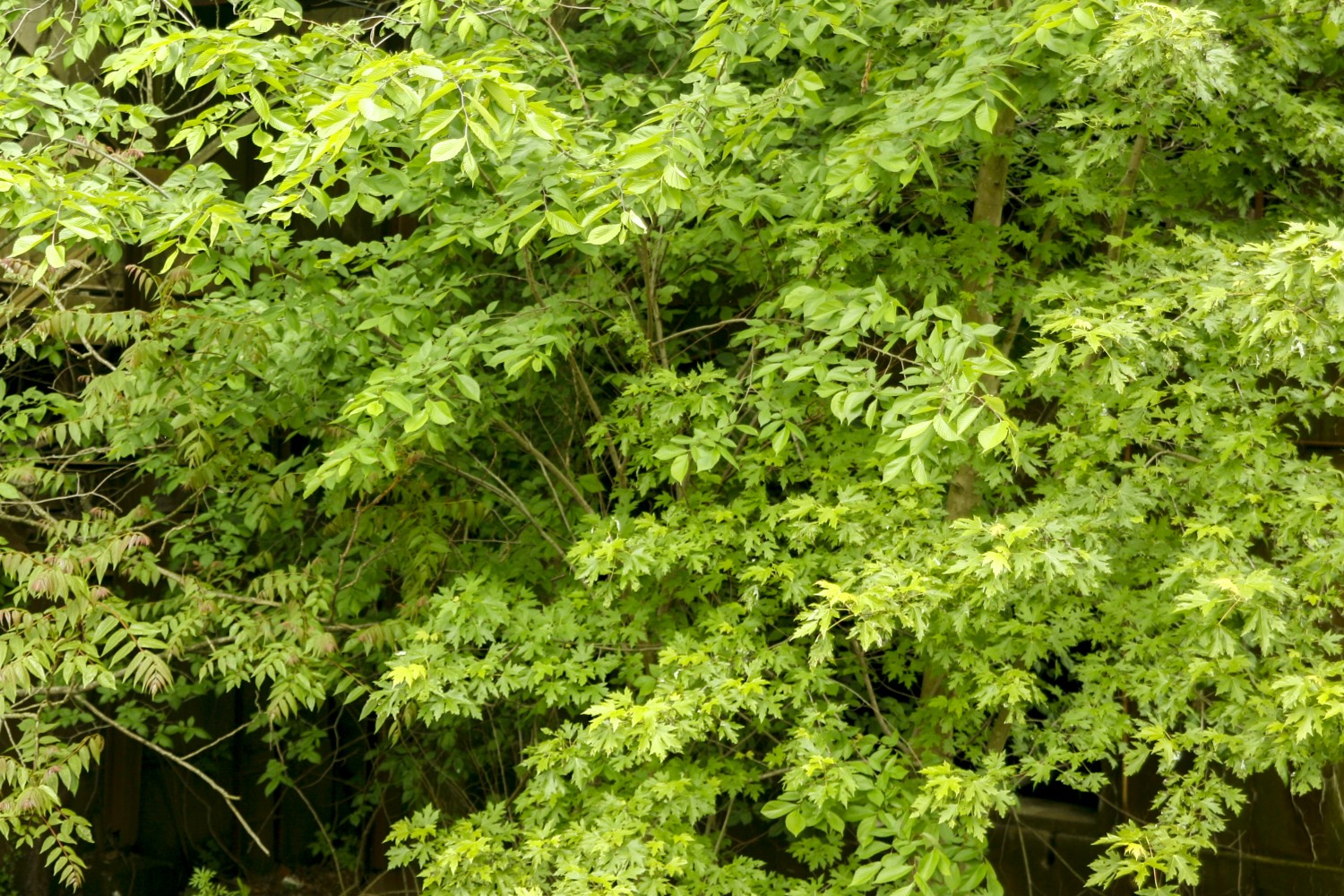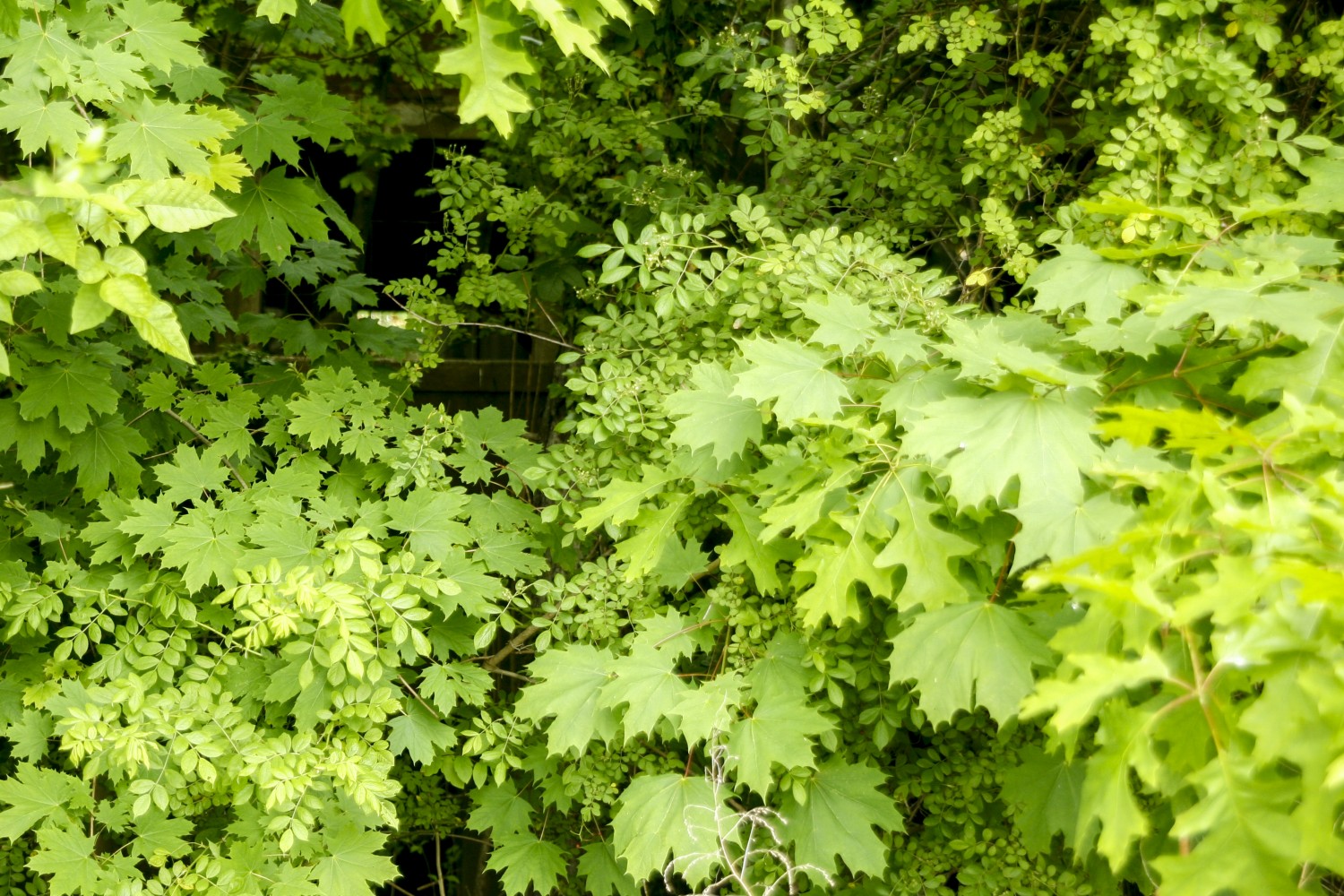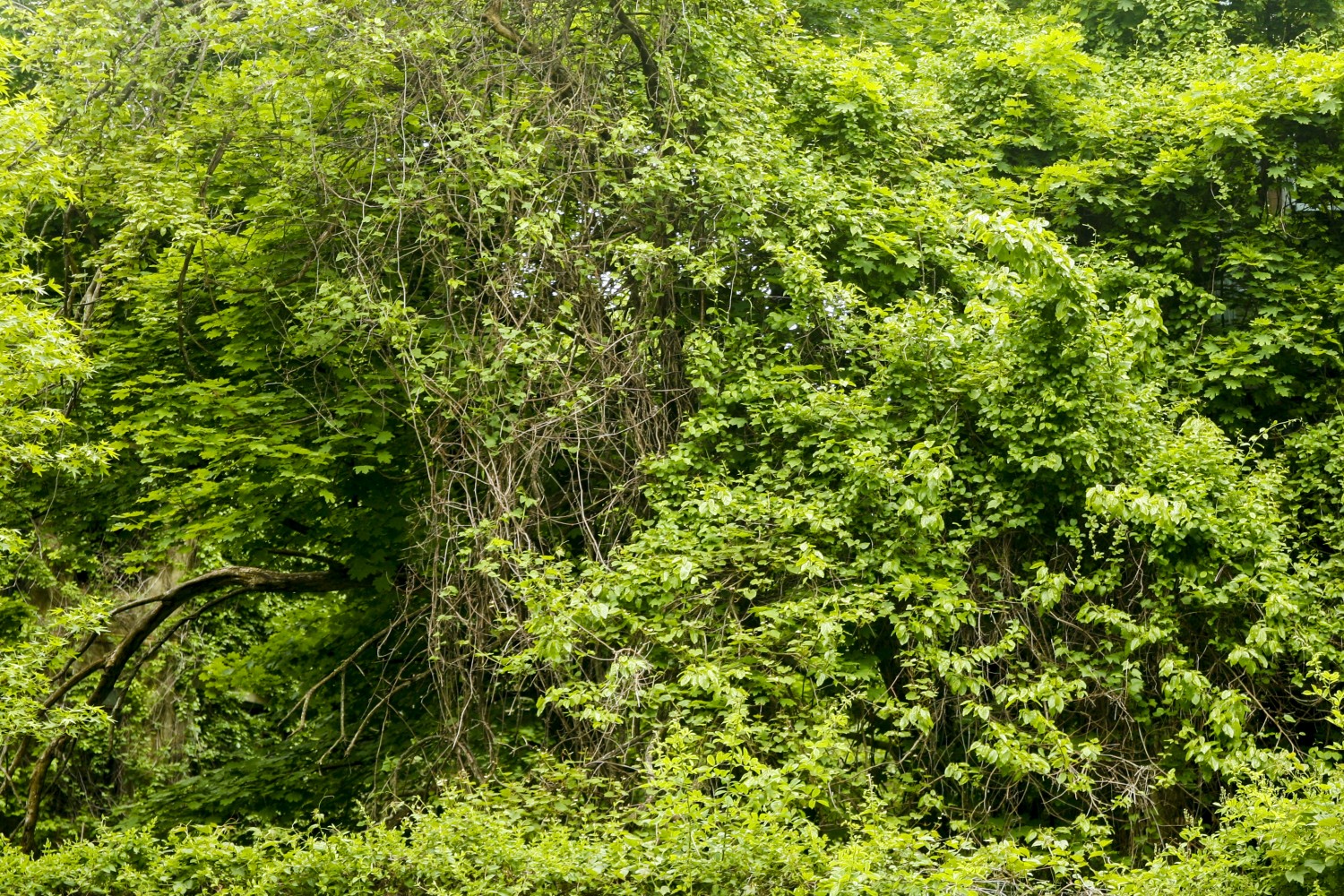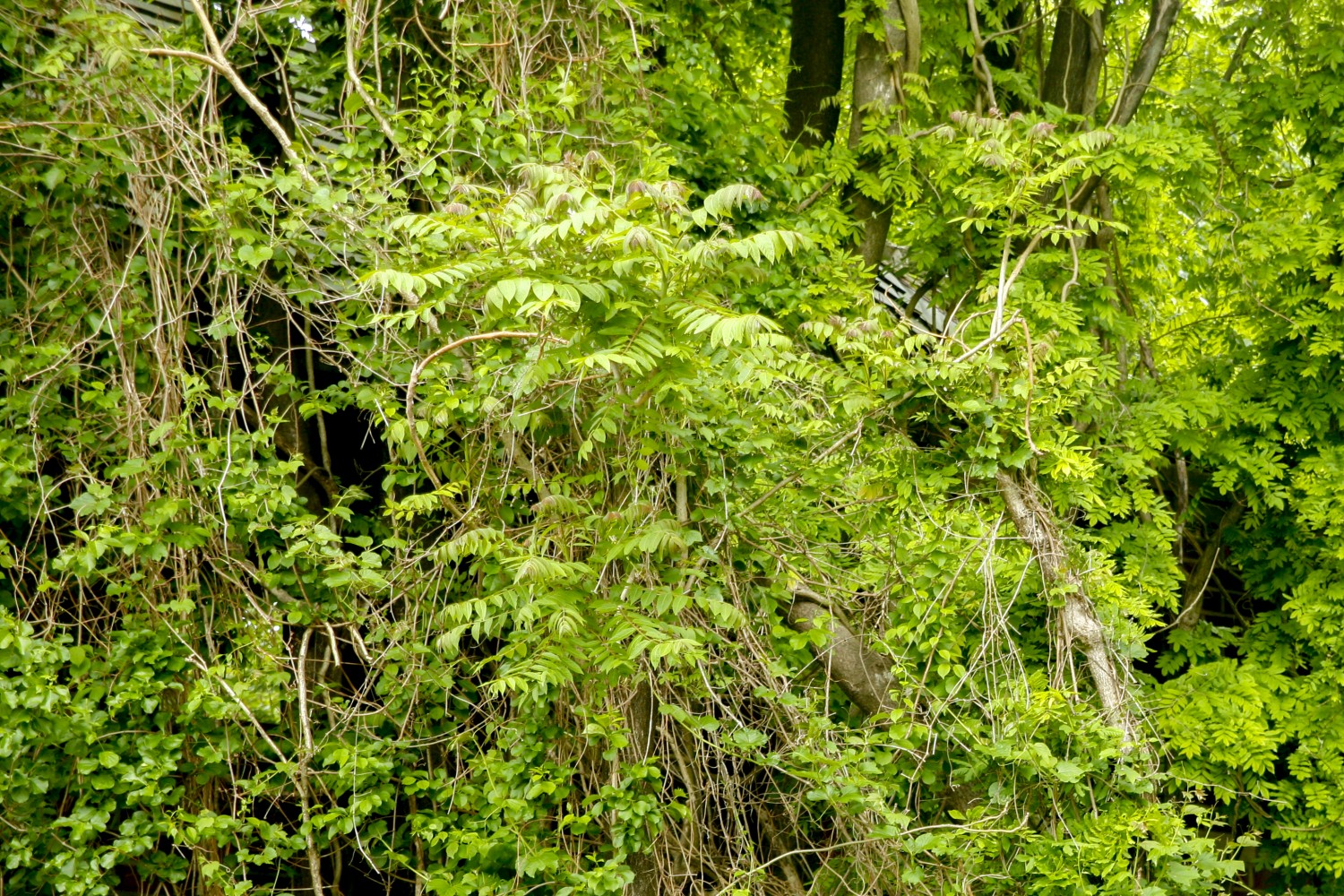웃자람(Overgrowth), 타일러 코번(Tyler Coburn)
우리는 이런 걸 ‘웃자랐다’고 하지만 이 단어는 생각할수록 좀 이상하다. 생물인 이상 자라는 게 당연하지 않나? 그런데 어쩌다가 풍성함이 방치와 동의어인 양 간주되고, 우리가 지속적인 통제에 실패했다는 뉘앙스를 풍기게 된 걸까?
이 웃자란 덤불 뒤에 가려진 건물들도 방치되기는 마찬가지로, 지난 50여년간 버림받은 채로 앉아 있다. 20세기 초반에 지어진 이 ‘파빌리온’들은 폐결핵 치료를 전문으로 하는 미국 내 최대 규모의 시립 요양 병원 병동으로 사용됐다. 그 당시 폐결핵은 치료할 길이 없는 질병이었지만, 병에 대해 알려진 바가 아주 없지는 않았다. 공기로 전파되는 박테리아의 형태를 띤다는 점, 자연에서 시간을 보내는 것이 병을 완화하는 효과를 갖는다는 점은 이미 알려져 있었다. 그리고 실제 그러한 공간을 마련하기 위해 요양원들이 생겨났고, 이 시설들을 찾은 이들 중에는 운 좋게 회복을 하는 경우도 간혹 있었다.
뉴욕 스태튼섬 고지에 자리한 이 병동들의 포치에까지 바닷바람이 불어오던 때가 한때 있었다. 맨해튼에서 제법 떨어진 이곳에서 요양 환자들은 호젓하게 휴양하는 차분함을 만끽했을 수도 있겠고, 도심에서 최대한 떨어진 뉴욕시의 가장 끝자락에 우리를 방기했다고, 병들고 죽어가는 사람들을 멀찍이 은폐하려 든 것이라고 느꼈는지도 모르겠다.
We call this “overgrowth,” which is a strange word when you think about it. Isn’t the tendency of things to grow? Why has abundance become synonymous with neglect, suggesting that we have failed to maintain control?
The pavilions this overgrowth conceals are also neglected, sitting abandoned for about fifty years. They were built in the early Twentieth Century as part of the largest municipal hospital in the United States for the treatment of tuberculosis. At the time, the disease was still incurable, though a few things were known: that it took form as bacteria spread by air, and that frequent exposure to the natural elements could have palliative effects. In the sanatoriums built to provide this amenity, some were lucky enough to get better.
Here, high up on Staten Island, a breeze lifting from the sea once filled the porches of these pavilions. Here, at a considerable distance from Manhattan, patients may have experienced the calm of a secluded retreat, or felt that the city had placed them as far away (within its limits) as it could—a hiding place for the sick and dying.

병원은 1905년에 착공해 그로부터 몇 년 후 개원했다. 그사이 부유층의 폐결핵 발병율은 꾸준히 줄어들고 있었던 반면, 뉴욕 내 폐결핵 환자들의 대다수는 이민자이거나 빈곤층에 속했다. 주요 환자층이 이러했기 때문인지 폐결핵이 전파성 질병이었기 때문인지는 몰라도, 병원에서 근무하던 백인 간호사들은 1929년 동맹 파업을 선언했다. 이후 인종 분리를 하지 않는 통합 병동의 환자들을 돌볼 인력으로 흑인 간호사들이 미국 역사상 최초로 고용되었다. “블랙 앤젤”이라고도 불린 이 3백여 명의 여성들은 당대의 필수 인력인 셈이었다.
1952년에는 폐결핵 약물 치료법의 개발과 시험이 이 병원에서 이루어졌다. 이후 기존의 약물 두 종과 결합함으로써 치유율 90~95%의 전례 없는 치료약을 개발하기에 이르렀다. 환자들은 어깨춤을 추었다.
1960년대 초반에 이르러 환자가 단 한 명도 남지 않자, 병원은 폐결핵 전문 요양원에서 점차 변화를 꾀하며 재활 치료 및 장기 간호 서비스를 도입했다. 몇몇 부속 건물들은 다른 용도로 전용되고 신축 건물도 들어섰지만, 파빌리온을 비롯한 부지 내 상당수의 시설들이 사용이 중지된 채 덩그러니 남겨졌다. 지금도 파빌리온들은 병원 부지를 두르는 펜스 뒤에서 재사용될 날만을 기다리고 있다. 개발 계획이 거론되다 다시 무산되는 와중에도 이 건물들은, 그 주변을 뒤덮은 나무와 덤불처럼, 웃자라고만 있다.
Construction began in 1905, with services commencing a few years later. By this point, tuberculosis cases among the wealthy were on a steady decline, and the majority of infected New Yorkers were immigrants and the poor. Perhaps it owes to this population, or perhaps to the contagious nature of the disease, that the hospital’s white nurses staged a walkout in 1929. For the first time in the country’s history, black nurses were hired to tend to patients in unsegregated wards. These three-hundred women, called “The Black Angels,” were the essential workers of their age.
In 1952, a drug treatment was developed and tested here. Combined with two existing drugs, it created an unprecedented remedy with a 90-to-95% cure rate. Patients danced in the aisles.
By the early 1960s, none were left, and this site began to transform, introducing rehabilitation and long-term nursing care. Some of the buildings were repurposed, and new ones were built, but many, like these pavilions, remained empty. Now, they sit behind a fence on the outskirts of the campus, waiting for possible reuse. Development plans have come and gone while the buildings, like the trees around them, overgrow.

나는 5월에 이 장소를 처음 찾았다. 코로나바이러스로부터 회복한 지 한 달 되는 시점에 마스크와 항체로 무장하고 방문했다. 파빌리온 내부는 사진으로 이미 봤기에 파빌리온을 둘러보겠다고 방문한 건 아니었다. 내가 접한 사진들은 “폐허 포르노(ruin porn)”란 불미스런 이름이 붙은 장르의 사진들로, 무단 출입을 감행해 태그(태깅)를 남기고 그래피티를 감상하거나 허물어져가는 건물 외관을 카메라에 담는 겁 없는 탐험가들의 작업물이다.
도심의 스필렁커(동굴 탐험가)들은 유독 폐허로 변한 병원과 요양원에 이끌리는 듯하다. 우리에게 더이상 크나큰 영향을 미치지 않는 당대의 질병과 질환을 신속히 치료하기 위해 마련했던 시설들, 시간이 지나면서 차츰 폐기되기에 이른 과거의 치료(곧 훈육) 개념에 근거했던 시설들에 말이다. 그런데 이런 시설들을 망각하려는 게 목표라면 차라리 철거 후 새로 짓거나, 망각에 이를 때까지 시설 개보수를 반복하는 방법을 택하는 편이 낫지 않을까? 웃자란 수풀로 뒤덮여 있기는 해도, 이 건물들은 지난날을 상기시킬 뿐이다.
이런 사진들이라면 누구나 인터넷에서 쉽사리 찾아볼 수 있다. 이미지도 아주 많다. 당신도 당신이 사는 도시나 마을 외곽을 탐사하며 이런 사진을 직접 찍어볼 수 있을 테다. 하지만 이런 이미지가 우리에게 시사하는 바가 뭔지 난 잘 모르겠다. 사진을 찍고자 무단 침입을 감행한 모험가가 또 한 사람 있었다는 사실을 알려준다는 점 외에는. 기록 · 문서화 작업이라기보단 고스 취향의 키치처럼 작용한다. 벗겨진 페인트, 얼룩진 매트리스, 쓰러진 휠체어는 끔찍한 장면을 연상케 한다. 어둡고 습한 복도는 귀신이 숨어 있기에 딱 좋아 보인다. 썩어가도록 방치된 건물들에 얽힌 역사와 그 맥락은? 모두 크로핑되어 잘려 나갔다.
I first visited this site in May, a month after recovering from coronavirus, equipped with my mask and antibodies. I wasn’t looking to explore the pavilions, as I had already seen photographs of their interiors. These pictures, belonging to a genre with the unfortunate name “ruin porn,” are the work of intrepid explorers who trespass to leave their tag, admire the graffiti, or snap the crumbling husks.
Urban spelunkers have a particular fascination with abandoned hospitals and asylums, many built for the express treatment of a disease that no longer plagues us as it once did, or with a conception of treatment (read: discipline) since discarded. If forgetting is the goal, then wouldn’t it be better to level and rebuild, or renovate into oblivion? These buildings, though cloaked in overgrowth, remind.
You can find those images online. There are so many of them. You can explore the fringes of your city or town and take them yourself. I don’t know what they tell us,beyond the fact of an adventurer whom, like so many before, trespassed to get a shot. They operate less as documentation than Gothic kitsch. The peeling paint, stained mattresses, and toppled wheelchairs conjure awful scenes. The dank hallways look perfect for skulking ghosts.The histories and contexts of buildings left to rot—these are cropped out.

그런 사진들에는 어딘가 거북하고 불미스런 면이 있고 그래서 포르노에 비유되는 건지도 모르겠다. 헐벗은 건축물, 헤아림 없이 담아낸 대상들… 내 이미지들은 그에 비해 “볼 게” 훨씬 적지만, 내 생각에 웃자란 풀숲은 그 자체로 우리에게 전하는 이야기가 있다. 방치하고 유기하는 우리들의 어떤 경향에 대해서는 물론, 현재를 살아가는 나와 같은 사람이 어떻게 경의를 표해야 하는지에 대해서도 말이다. 이 건물들 안에서 사람들이 고통을 겪고 사람들이 목숨을 잃었다. 저 나뭇가지들이 저리 무성히 자란 건 그들을 보호하기 위해서이다.
내가 여러분에게 보여주지 않은 것도 있다. 마스크와 수술복 을 입고 병원 부지 내를 돌아다니는 지금 이 순간의 필수 인력들. 코로나바이러스로 세상을 떠나고 만 이들을 안치하고자 방치된 건물 옆에 설치한 컨테이너 임시 영안실.
과거의 팬데믹으로부터 우리가 배울 교훈은 무엇인가? 우리가 요즘 자주 제기하는 질문이다. 그러면서 어느 정도 안도감을 얻기도 한다. 백신이 성공적으로 개발되는 날을 상상하는 데 도움이 되고, 설사 백신 개발에 실패한대도 우리 안의 낯선 자와 어떻게 살아가야 할지를 상상하는 데 도움이 되는 까닭이다. 내가 이곳을 찾은 것도, 그리고 여러분이 읽고 있는 이 글을 파빌리온 건물들이 늘어선 한복판에서 폰에 대고 낭독했던 것도 그런 이유에서였는지 모르겠다. 이 사이트(장소)는 접혀진다. 접을 수가 있다. 이렇게 주름을 잡으면 팬데믹 두 개가 맞닿는다. 하지만 내가 혹시라도 이곳에서 어떤 명료함을 얻길 바랐다면 그건 내가 한참 헛짚은 거다. 이곳엔 웃자란 덤불만 무성하다.
There’s something obscene about that type of photography, which may be why it’s likened to porn. Buildings stripped bare, objects without reference ... In my images, there’s less to “see,” but I think the overgrowth tells a story: certainly, of our capacity to neglect, but also of how a person like me, in the present, should confer respect. People suffered in these buildings, and people died. The branches have grown thick to protect them.
There are other things I’m not showing you: the essential workers of today, in masks and scrubs, walking around the campus; the temporary morgue container, installed beside one of the abandoned buildings, that houses those lost to coronavirus.
What can we learn from past pandemics? So many of us are asking this question. The exercise can provide a measure of relief, helping us imagine a future when a vaccine is found or, failing that, how to live with our stranger. Perhaps this is why I came, and why the words you’re reading I spoke out loud, into my phone, surrounded by the pavilions. This site can be folded. Creased just so, two pandemics touch. But if I had expected to find clarity, then I’m sorely mistaken. Here, there is nothing but overgrowth.
타일러 코번 Tyler Coburn
타일러 코번은 뉴욕을 기반으로 활동하는 아티스트이자 저술가이다.
Tyler Coburn is an artist and writer based in New York.
/
번역 이예원
Translated by Emily Yae Won

